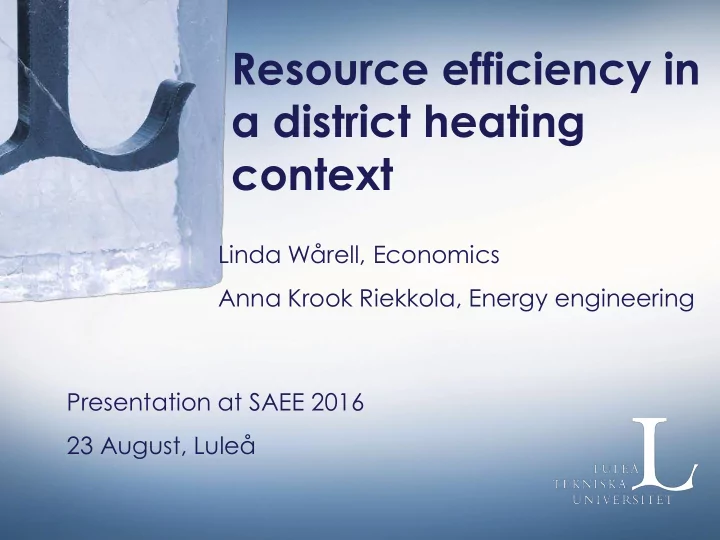

Resource efficiency in a district heating context Linda Wårell, Economics Anna Krook Riekkola, Energy engineering Presentation at SAEE 2016 23 August, Luleå
Agenda • Motivation – Resource efficiency • Resource efficiency in a district heating context – No/low alternative use – CHP • Energy system analysis – Times-Sweden • Results • Concluding remarks
Motivation • Resource efficiency • On the EU agenda – The resource-efficient Europe flagship – Roadmap to a resource efficient Europe • Resource efficiency in Energy systems – Heat pumps? – District heating? • Main aim to analyse resource efficiency in the Swedish Energy System
Efficiency • Efficiency – Fundamental economic problem about society making optimal use of scarce resources • Economic efficiency – Occurs when society is using its scarce resources to produce the highest possible amount of goods and services that consumers demand • Pareto efficiency – A situation in which it is impossible to make one person better off without making anyone else worse off • Productive efficiency – When producers minimize the waste of resouces in their production processes – produces at lowest cost
Resource efficiency • Resource efficiency – Using resources in a way to produce more with less input • Productivity – Productive use of the resources, and taking into account the whole life cycle • Requires – Extracting and using resources in a sustainable way – Minimizing impacts of the use of one resource on other natural resources • Energy – Demand for energy have implications for all resource domains: air, fossil fuels, timber, biomass, water and land.
Resource efficiency – District heating • Uses resources with no/low alternativ use – Forest residuals, waste, industrial waste heat – Saves other resources for other purposes than heat generation (electricity, biomass, coal and oil). – Also economic efficient as these resources have a low production cost. • Combined Heat and Power – CHP in combination with district heating increases energy efficiency and decreases CO 2 emissions – Resource efficient production of electricity – District heating provides opportunities for CHP
Energy system analysis • Long term impacts of District Heating (DH) as part of the Swedish energy system is assessed • National Energy System model – TIMES Sweden: – Partial equilibrium model – demand driven – Includes 7 sectors (Industry, Agriculture, Commercial, Residential, Transportation, Electricity and DH, Supply) – Capture competition of fuels within and b/w sectors – Based on Eurostat statistics • Two Scenarios: – DH scenario – reference – No DH scenario
Assumptions • Energy demand: – Calibrated from data in 2000, 2005, 2010 – until 2050 – Based on future demand from soft-linking with EMEC – Aggregated demand in residential sector is assumed to decrease with 5% from 2010 to 2050 • Marginal prices calculated in model: – Coal, oil and natural gas exogenous – EU-ETS are based on IEA’s World Energy Outlook • Statistics from: – Eurostat – Statistics Sweden – Swedish Energy Agency
Results • Energy use: – Space heating and domestic hot water in the residential and service sectors – Final energy use – illustrates what is purchased and registered in the statistics – Useful energy – illustrates the energy mixes that meets the assumed demand for heating • No DH scenario: – Heat pumps replace b/w 53-65% – Natural gas replace b/w 20-25% – Biomass replace b/w 6-20% – Electricity only replace about 8%
Results (PJ) (TWh) 350 97 300 83 250 69 200 56 150 42 100 28 14 50 0 0 2020 2030 2040 2050 2020 2030 2040 2050 With DH (2D) No DH (2D) 1Elec-Only 2Elec-HP 3Biomass 5Natural gas 6Oil 7District heating 8Solar
Results (PJ) (TWh) 350 97 300 83 250 69 200 56 150 42 100 28 50 14 0 0 2020 2030 2040 2050 2020 2030 2040 2050 With DH (2D) No DH (2D) 1Elec-Only 2Elec-HP 3Biomass 5Natural gas 6Oil 7District heating 8Solar
Results • Electricity supply: – Swedish electricity system is characterized by nuclear and hydropower – Demand and supply varies over the years (temperature, downfall, nuclear maintenance) – Balanced by cross-border trade • No DH scenario: – Nuclear and hydropower is assumed constant – Electricity generation is higher – Less electricity export – Waste (incineration and derived gases) and biomass CHP is not used for electricity generation
Results Year: 2010 2011 2012 2020 2020 2030 2030 2040 2040 Scenario: Statistics* DH No DH DH No DH DH No DH Hydro 66.5 66.3 78.6 69.4 69.4 69.4 69.4 69.4 69.4 Nuclear 55.6 58.0 61.4 60.3 60.3 61.4 61.4 61.4 61.4 Coal 0.1 0.1 0.0 0.0 0.0 0.0 Oil 0.1 1.5 0.0 0.3 0.0 0.0 6.5 3.9 2.5 Natural gas 0.2 0.8 0.1 1.8 1.4 2.7 Derived gases 0.1 0.1 0.5 0.1 1.3 0.0 Peat 0.7 0.6 0.4 0.0 0.0 0.0 0.0 0.0 0.0 Waste 2.9 3.1 2.8 3.1 0.0 3.0 0.0 0.9 0.0 Biomass 10.6 9.7 10.6 9.1 0.1 10.0 0.0 11.0 0.0 Wind 3.5 6.1 7.2 7.1 18.8 9.1 23.9 8.6 24.3 Total 146.3 147.7 163.4 149.5 151.0 153.6 157.0 154.0 157.9 generation Net export -2.1 7.2 19.6 19.5 19.1 18.6 19.0 19.4 11.2 �
Results – Resource efficiency • Resources with no/low alternativ use: – Biomass Logging residues no longer used – Waste What happens to the waste market? – Industrial waste heat – Higher grade fuel sources (e.g. electricity, natural gas, coal) need to be used for heat) • Combined Heat and Power – Production of electricity from CHP reduces considerably in No DH scenario – Decreases resource efficiency
Conclusions • Heat pumps will be dominant heat source in residential and service: – Electricity demand increases by 13 TWh/year – Is met by increase of wind power – decrease in CHP • Resource efficiency: – Is decreased in the No DH scenario – Use of alternative fuel sources decreases – Higher grade fuel sources are needed for heat – The possibility for CHP plants is decreased • Furthermore, less flexible energy system
Questions?
Recommend
More recommend